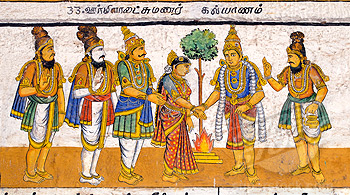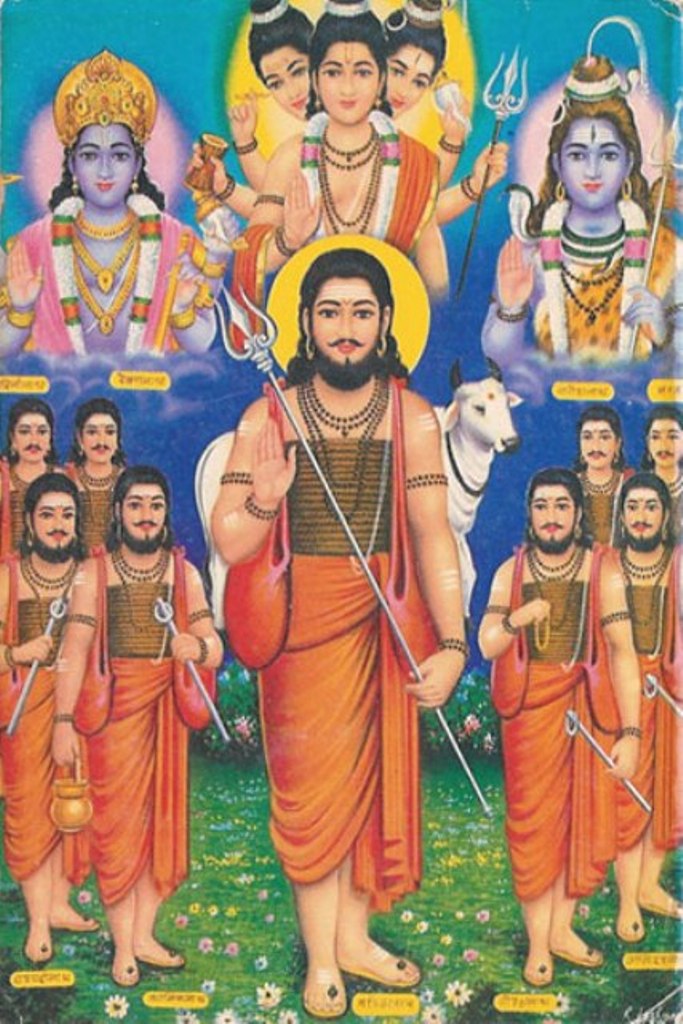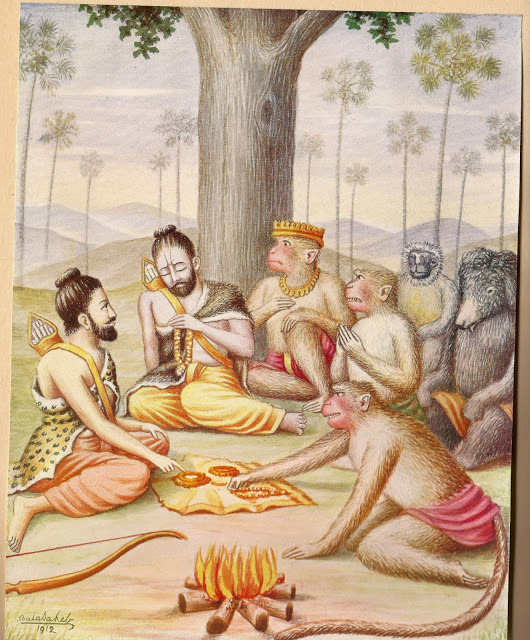|
Shabari
Shabari (, ), also known as Bhilni, Bhilani, and Shramana, is an elderly woman ascetic in the Hindu epic ''Ramayana''. She is described as an ardently devoted woman who received Rama's blessing due to her bhakti towards him. Story Shabari was a woman from a village. According to Krishna Dutt, she was a seeker of knowledge and wanted to know the meaning of Dharma. After days of travel, she met Sage Matanga at the foot of Mount Rishyamukha. She accepted him as ''guru'', serving him with devotion for many years. When Matanga was about to die, Shabari, now elderly, stated that after serving him throughout her life, she now sought to reach for herself the same "abode of peace" which Matanga had reached. The sage responded that, if she offered '' seva'' (service), the god Rama would give her '' darshana''. He told her to await Rama's arrival. Then, while sitting in lotus posture, the sage attained '' Mahasamadhi''. Following her guru's advice, Shabari awaited Rama's arrival. ... [...More Info...] [...Related Items...] OR: [Wikipedia] [Google] [Baidu] |
Sabarimala
The Sabarimala Sree Dharma Sastha Temple () is a Hindu temple dedicated to the god Ayyappan, who is also known as Dharma Shasta and is the son of the deities Shiva and Mohini (female avatar of the god Vishnu). The temple is situated atop the Sabarimala hill in the village of Ranni-Perunad, within the Ranni Taluk, Thiruvalla Revenue Division of Pathanamthitta district in the state of Kerala, India. The temple is surrounded by 18 hills in the Periyar Tiger Reserve. It is one of the largest annual pilgrimage sites in the world, with an estimate of over 10 to 15 million devotees visiting every year. The temple is open for worship only during the days of ''Mandala Pooja'' (approximately 15 November to 26 December), '' Makaravilakku'' or Makara Sankranti (14 January), Maha Thirumal Sankranti (14 April), and the first five days of each Malayalam month. The Sabarimala Temple serves as a prime example of the amalgamation of several religious traditions within the Indian contex ... [...More Info...] [...Related Items...] OR: [Wikipedia] [Google] [Baidu] |
Uchchhishta
''Uchchhishta'' (, , ), known by various regional terms, is an Indian and a Hindu concept related to the contamination of food by saliva. Though the term has various meanings and has no exact parallel in English,Roy p. 107 it is generally translated in English as "leftovers"Olivelle pp. 354-5 or "leavings", but with a denigratory aspect. ''Uchchhishta'' frequently denotes the food scraps remaining after a person has eaten. In a broader sense, it refers to the contamination of a food or hand that has come in contact with saliva or the inside of the mouth. A person or plate is said to be ''uchchhishta'' after coming into contact with ''uchchhishta'' food. ''Uchchhishta'' food, people and utensils are considered to be ritually impure. A person can become purified by washing their hand (Hindus traditionally eat with their fingers) and mouth. It is highly disrespectful to offer ''uchchhishta'' food to someone, however exceptions exist for food from socially superior individuals, and ot ... [...More Info...] [...Related Items...] OR: [Wikipedia] [Google] [Baidu] |
Rama
Rama (; , , ) is a major deity in Hinduism. He is worshipped as the seventh and one of the most popular avatars of Vishnu. In Rama-centric Hindu traditions, he is considered the Supreme Being. Also considered as the ideal man (''maryāda'' ''puruṣottama''), Rama is the male protagonist of the Hindu epic '' Ramayana''. His birth is celebrated every year on Rama Navami, which falls on the ninth day of the bright half ( Shukla Paksha) of the lunar cycle of Chaitra (March–April), the first month in the Hindu calendar. According to the ''Ramayana'', Rama was born to Dasaratha and his first wife Kausalya in Ayodhya, the capital of the Kingdom of Kosala. His siblings included Lakshmana, Bharata, and Shatrughna. He married Sita. Born in a royal family, Rama's life is described in the Hindu texts as one challenged by unexpected changes, such as an exile into impoverished and difficult circumstances, and challenges of ethical questions and moral dilemmas. The most not ... [...More Info...] [...Related Items...] OR: [Wikipedia] [Google] [Baidu] |
Ramayana
The ''Ramayana'' (; ), also known as ''Valmiki Ramayana'', as traditionally attributed to Valmiki, is a smriti text (also described as a Sanskrit literature, Sanskrit Indian epic poetry, epic) from ancient India, one of the two important epics of Hinduism known as the ''Itihasas'', the other being the ''Mahabharata''. The epic narrates the life of Rama, the seventh ''avatar'' of the Hindu deity Vishnu, who is a prince of Ayodhya (Ramayana), Ayodhya in the kingdom of Kosala. The epic follows Exile of Lord Rama, his fourteen-year exile to the forest urged by his father King Dasharatha, on the request of Rama's stepmother Kaikeyi; his travels across the forests in the Indian subcontinent with his wife Sita and brother Lakshmana; the kidnapping of Sita by Ravana, the king of Lanka, that resulted in bloodbath; and Rama's eventual return to Ayodhya (Ramayana), Ayodhya along with Sita to be crowned as a king amidst jubilation and celebration. Scholarly estimates for the earliest stage ... [...More Info...] [...Related Items...] OR: [Wikipedia] [Google] [Baidu] |
Bollywood
Hindi cinema, popularly known as Bollywood and formerly as Bombay cinema, is primarily produced in Mumbai. The popular term Bollywood is a portmanteau of "Bombay" (former name of Mumbai) and "Cinema of the United States, Hollywood". The industry, producing films in the Hindi language, is a part of the larger Indian cinema industry, which also includes Cinema of South India, South Indian cinema and other smaller Cinema of India#Cinema by language, film industries. The term 'Bollywood', often mistakenly used to refer to Indian cinema as a whole, only refers to Hindi-language films, with Indian cinema being an umbrella term that includes all the Cinema of India#Cinema by language, film industries in the country, each offering films in diverse languages and styles. In 2017, Indian cinema produced 1,986 feature films, of which the largest number, 364, have been in Hindi. In 2022, Hindi cinema represented 33% of box office revenue, followed by Telugu cinema, Telugu and Tamil cine ... [...More Info...] [...Related Items...] OR: [Wikipedia] [Google] [Baidu] |
Lakshmana
Lakshmana (, ), also known as Laxmana, Lakhan, Saumitra, and Ramanuja, is the younger brother of Rama in the Hindu epic ''Ramayana''. He is considered as an incarnation of Shesha, the lord of serpents. Lakshmana was married to Urmila, and is known for his loyalty and dedication towards Rama. Lakshmana was born to King Dasharatha of Ayodhya and Queen Sumitra. Shatrughna, is his twin brother. He was married to Urmila, after his brother Rama married Sita in her swayamvara. Lakshmana devoted himself to Rama since childhood and accompanied him during his fourteen-year exile, serving him and Sita endlessly. He also played a pivotal role in the war and killed Meghanada. Lakshmana is worshipped in Hinduism, at various places in India, alongside Rama and Sita. Etymology The name Lakshmana is of Sanskrit origin, which means 'the one endowed with auspicious signs'. He bears the epithets of Saumitra (, ) and Ramanuja (, ). Legend Birth and early life King Dasharatha of A ... [...More Info...] [...Related Items...] OR: [Wikipedia] [Google] [Baidu] |
Nath Sampradaya
Natha, also called Nath (), are a Shaiva sub-tradition within Hinduism in India and Nepal. A medieval movement, it combined ideas from Buddhism, Shaivism, Tantra and Yoga traditions of the Indian subcontinent.Natha: Indian religious sect Encyclopedia Britannica (2007) The Naths have been a confederation of devotees who consider as their first lord or , with varying lists of additional gurus. Of these, the 9th or 10th century |
Bhajana
Bhajan is an Indian term for any devotional song with a religious theme or spiritual ideas, specifically among Dharmic religions, in any language. The term bhajanam (Sanskrit: भजनम्) means ''reverence'' and originates from the root word ''bhaj'' (Sanskrit: भज्), which means ''to revere'', as in 'Bhaja Govindam' (''Revere Govinda'')''. ''The term bhajana also means ''sharing''. The term bhajan is also commonly used to refer to a group event, with one or more lead singers, accompanied with music, and sometimes dancing. Normally, bhajans are accompanied by percussion instruments such as '' tabla'', dholak or a tambourine. Handheld small cymbals (''kartals'') are also commonly used to maintain the beat. A bhajan may be sung in a temple, in a home, under a tree in the open, near a river bank or a place of historic significance.Anna King, John Brockington, ''The Intimate Other: Love Divine in Indic Religions'', Orient Longman 2005, p 179. A group of bhajan performer ... [...More Info...] [...Related Items...] OR: [Wikipedia] [Google] [Baidu] |
Japa
''Japa'' () is the meditative repetition of a mantra or a divine name. It is a practice found in Hinduism, Jainism, Sikhism, and Buddhism, with parallels found in other religions. ''Japa'' may be performed while sitting in a meditation posture, while performing other activities, or as part of formal worship in group settings. The mantra or name may be spoken softly, loud enough for the practitioner to hear it, or it may be recited silently within the practitioner's mind. Etymology The Sanskrit word ''japa'' is derived from the root ''jap-'', meaning "to utter in a low voice, repeat internally, mutter". It can be further defined as ''ja'' to destroy birth, death, and reincarnation and ''pa'' meaning to destroy ones sins. Monier-Williams states that the term appears in Vedic literature such as in the Aitareya Brahmana (Rigveda) and the Shatapatha Brahmana (Yajurveda). The term means muttering, whispering or murmuring passages from the scripture, or charms, or names of deity. ... [...More Info...] [...Related Items...] OR: [Wikipedia] [Google] [Baidu] |
Kirtana
Sikh ''kirta''n with Indian harmoniums and '' Kenya.html" ;"title="tabla'' drums (a common and popular pairing), in Kenya">tabla'' drums (a common and popular pairing), in Kenya (1960s) ''Kirtana'' (; ), also rendered as ''Kiirtan'', ''Kirtan'' or ''Keertan'', is a Sanskrit word that means "narrating, Bhajan, reciting, telling, describing" of an idea or story, specifically in Indian religions. It also refers to a genre of religious performance arts, connoting a musical form of narration, shared recitation, or devotional singing, particularly of spiritual or religious ideas, native to the Indian subcontinent. A person performing kirtan is known as a ''kirtankara'' (or ''kirtankar,'' कीर्तनकार). With roots in the Vedic ''anukirtana'' tradition, a kirtan is a call-and-response or antiphonal style song or chant, set to music, wherein multiple singers recite the names of a deity, describe a legend, express loving devotion to a deity, or discuss spiritual ideas. ... [...More Info...] [...Related Items...] OR: [Wikipedia] [Google] [Baidu] |
Satsang
Satsang () is an audience with a satguru for the purpose of spiritual or yogic instruction. The ''satsanga'' is a gathering of good people for the performance of devotional activities. Meanings The word is derived from the Sanskrit ''sat'' meaning "purity or truth", and ''sanga'' meaning "in group or association". Thus the literal meaning of ''satsang'' is "the company of Truth", but it holds multiple meanings within the Sant (religion), Sant and Bhakti traditions of northern India. Charlotte Vaudeville defines Sant as a distinct tradition because of its emphasis on devotion to the Divine Name (satnam), the Divine Guru (satguru), and the importance of the company of devotees (satsang). "Sat (Sanskrit), Sat" (truth) in Indian traditions refers to that which is eternal and changeless. Along with "Chit (consciousness), Cit" (consciousness) and Ānanda (Hindu philosophy), Ānanda (bliss), it is a quality of Brahman (supreme being). In this context, Satsang represents an experience of ... [...More Info...] [...Related Items...] OR: [Wikipedia] [Google] [Baidu] |
Sugriva
Sugriva (, ), is a character In the ancient Hindu epic Ramayana. He is the younger brother of Vali (Ramayana), Vali, whom he succeeded as ruler of the vanara kingdom of Kishkindha. He is a son of Surya, the Hindu deity of the sun. As the king of the vanaras, Sugriva aided Rama in his quest to liberate his wife Sita from captivity at the hands of the rakshasa king Ravana. Nomenclature He is also known as , , , , , Creole language, Creole: Soogrim, , , , Sugreeva or Sugreev. Malayalam:Sugreevan. Legend The story of Sugriva is part of Ramayana and in an abbreviated version, is also present in the Mahabharata. The king of Kishkindha, Vrikshraja, was a divine creature born from Brahma's tilaka. He had the body of a human and face and tail of a monkey. He was instructed to roam the forests and kill demons. One day, Vriksharaja entered an enchanted pond, and was transformed into a beautiful lady, attracting the attention of both Indra and Surya. Soon after, they each sired Vali ... [...More Info...] [...Related Items...] OR: [Wikipedia] [Google] [Baidu] |








